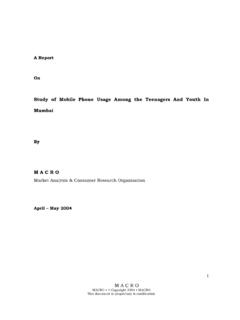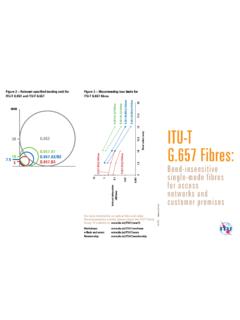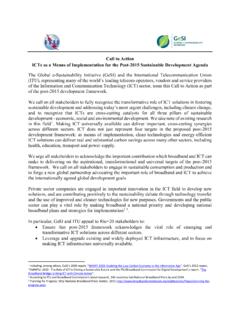Transcription of IEEE 802 1AS and IEEE 1588IEEE 802.1AS and IEEE 1588 ... - ITU
1 Joint ITU-T/IEEE Workshop on The Future of Ethernet Transporton The Future of Ethernet Transport(Geneva, 28 May 2010)IEEE 802 1AS and IEEE 1588 IEEE and IEEE 1588 Geoffrey M. GarnerSamsungSamsung(Consultant)Geneva, 28 May 2010 AcknowledgmentMany of the slides in this ypresentation were taken or adapted from references [1] [3]The author would like to acknowledge and thank John Eidsonacknowledge and thank John Eidson for having provided the base material from which many of thematerial from which many of the slides of reference [1] were taken or adaptedadaptedGeneva, 28 May 20102 OutlinePurpose of IEEE 1588 Purpose of IEEE 1588 IEEE 1588 version 2 featuresIEEE 1588hi tiiIEEE 1588 synchronization using peer delay mechanismPurpose of IEEE profile included in IEEE synchronizationIEEE 802 1AS best master selectionIEEE best master selectionGeneva, 28 May 2010388l ()
2 Purpose of IEEE 1588 IEEE 1588 precision time protocol (PTP) is a protocol designed to synchronize real- time clocks in the nodes of a distributed system that communicate yusing a networkIt does not say how to use these clocks (this is specified by the respective application areas)the respective application areas) NETWORKNETWORKG eneva, 28 May 201041588 V2 New Features 1 IEEE 1588TM 2008 (IEEE 1588 V2) [4] was published July 24, 2008. New features py,include:Mappings to UDP/IPv4&6, Ethernet (direct mapping), DeviceNetTMPROFINET ControlNetTMDeviceNetTM, PROFINET, ControlNetTMFormal mechanisms for message extensions (using TLV)Transparent clocksSynchronization accuracies better than 1 nsOptions for redundancy and fault toleranceNew management capabilities and optionsgHigher sampling rates compared to V1; asymmetry correctionsOptional unicast messaging (in addition to multicast)Optional unicast messaging (in addition to multicast)PTP profilesGeneva, 28 May 201051588 V2 New Features 2 IEEE 1588 V2 new features (cont.
3 :Conformance specificationsConfiguration optionsConfiguration optionsSecurity (experimental specification onlyMeans to accumulate cumulative frequency scale factor ffl id(ilifiioffset relative to grandmaster (experimental specification only)IEEE 1588 V2 contains a large number of 588o a s a a gu b ofeatures, not all of which are requiredEach application may use only a subset of those features that are optionalthat are optionalThe specification of the attribute values and optional features used is part of the PTP profile (The PTP profile included in IEEE 802 1AS is described in more detail later)included in IEEE is described in more detail later)Geneva, 28 May 20106 Synchronization using Peer Delay Mechanism 1eay ec a sFocus on two-step ordinary and boundary clocks using peer delay, because these are used in slave synchronizes to its master iS Fll UPdl Rusing Sync, Follow_Up, Pdelay_Req, Pdelay_Resp, and Pdelay_Resp_Follow_Up messages exchanged between master andmessages exchanged between master and its slaveGrandmaster ClockSlave to the Slave to its MasterGeneva, 28 May 20107 This clock determines the time base for the system Grandmaster Clock and Master to its Slave Synchronization using Peer Delay Mechanism 2eay ec a sMastertimeSlavetimetTimestamps knownby slavet1t2by slavet-msSyncFollow_Upt2t1.)
4 T2t4t3t-smPdelay_Reqt3tPdelay_Respt3, t4t5, t6t5t6 Pdelay_Resp_Follow_Upt6t4, t634, 56 Grandmaster- MS- BC - MS- OCGeneva, 28 May 20108 Synchronization using Peer Delay Mechanism 3eay ec a s3 Under the assumption that the link is symmetric ( , propagation time from master to slave = propagation time from slave to master)Off ttt(titi)(t)(titi)Offset = t2 t1 (propagation time ) = (t-ms) (propagation time )(propagation time ) = [(t4 t3) + (t6 t5)]/2If the link is not symmetricThe propagation time computed as above is the mean of the master-to-slave and slave-to-master propagationthe mastertoslave and slavetomaster propagation timesThe offset is in error by the difference between the actual master-to-slave and mean propagation timesGeneva.
5 28 May 20109actual mastertoslave and mean propagation timesThe protocol includes the means to correct for the error if it is measured separatelySynchronization using Peer Delay Mechanism 4eay ec a sThe peer delay mechanism is limited to point-to-point links between two clockspointtopoint links between two clocksThis is because the protocol does not provide for the clock that receives Pdelay_Req to keep track of which clock it receives the message from, and respond separately to each clockThis limitation is consistent with 802 1 ASThis limitation is consistent with between time -aware systems are logically point-to-point (need not be physically point-topoint)to-point)The mechanism operates separately and independently in both directions on a linkGeneva, 28 May 201010independently in both directions on a linkOverview of IEEE is the standard for transport of precise timing and synchronization in Audio/Video Bridging (AVB) networks(AVB)
6 Nodes are referred to as time -Aware SystemsIEEE is currently in sponsor ballotLatest draft is [5]As of the preparation of this presentation, the initial sponsor ballot has closedComment resolution is in progress, and will continue during the May 24 27, 2010 IEEE AVB TG meetingA recirculation is expectedA recirculation is expectedFinal approval expected later in 2010 Geneva, 28 May 201011 Overview of IEEE is based on IEEE 1588 V2, and includes a PTP profileTime-aware bridge acts as a boundary clock (but with peer-to-Timeaware bridge acts as a boundary clock (but with peertopeer transparent clock formulation of synchronization)Bridge participates in best master selection; this is driven by 3reasons:3 reasons.)
7 Fast reconfiguration to control phase transients when GM changesScalability (without best master selection at each bridge, larger timeout values needed for larger networks)timeout values needed for larger networks)Data spanning tree determined by RSTP not necessarily optimal for synchTime-aware end station acts as ordinary clockTimeaware end station acts as ordinary clockGeneva, 28 May 201012 PTP Profile Included in IEEE 1 Profile ItemSpecificationBest master clock algorithm (BMCA) optionAlternate BMCA (similar, but not identical, to 1588 clause 9)algorithm (BMCA) option1588 clause 9)Management mechanism SNMP MIBPath delay mechanismPeer delay mechanism802 1 ASifid f lSi l1 specifies default values; may specify additional ranges for each AVB profileSync interval: 1/8 sAnnounce interval: 1 sPdelay interval: 1 sfor each AVB profileAnnounce receipt timeout: 2 announce intervalsSync receipt timeout: 3 sync intervalsNode typesBoundary clock (synchronization specified in manner similar to peer-to-peer transparent clock.
8 BC and peer-to-peer TC synchronization can be shown to be mathematicallycan be shown to be mathematically equivalent, see [6])Ordinary clockPTP Profile Included in IEEE 2 Profile ItemSpecificationTransport Full-duplex IEEE shared network (CSN, , Multimedia over Coax Alliance (MoCA) specification, ITU-T )IEEE Ethernet passive optical network (EPON); uses facilities of IEEE multipoint control protocol (MPCP) (not part of PTP profile) wireless; uses facilities of IEEE [7] (not tfPTP fil)part of PTP profile)Optional featuresBridges/end-station required to measure frequency offset to nearest neighbor (but not required to adjust frequency)frequency)Nearest-neighbor frequency offset is accumulated and used to correct propagation time and compute synchronized timeyStandard organization TLV is defined to carry cumulative frequency offset and additional informationPTP Profile Included in IEEE 3 Profile ItemSpecificationOptional Standard organization TLV is defined for use in Signaling features (cont.
9 Message, to allow a node to request its neighbor to adjust message rate if it is going in or out of low power mode (to be used to support power management/Energy Efficient Ethernet (EEE))Efficient Ethernet (EEE))Path Trace feature, with associated TLV, is used and is mandatoryAcceptable master table is used for IEEE 802 3 EPONA cceptable master table is used for IEEE EPON links to ensure that optical line terminal (OLT) is master and optical network units (ONUs) are slaves; other optional features of IEEE1588 clauses 16 and 17 are not usedAnnex K security protocol is not usedAnnex L cumulative frequency scale factor is not used (blfffld)(but cumulative frequency offset is accumulated) Architecture and EntitiesTaken from Figure 10-1 of [5]ClockTarget(see Clause 9)ClockSource(see Clause 9)Application interface functions (Clause 9)
10 ClockSlaveClockMasterClockSlaveTimeSPtSS iteSyncPortSyncSyncPortSyncSyncMDSyncRec eiveMDSyncSendMSLLCMSLLCPortSyncPortSync MDMDMDSyncReceiveMDSyncSendLocalClockMAC relayMedia-dependenttime-aware system entitiesMedia-dependenttime-aware system entitiesPHYMACISSPHYMACISSS ynchronization in IEEE 180 SEvery IEEE port of a time -aware system runs peer delay mechanismMeasure propagation delay as specified in of IEEE 1588 Responder provides requestReceiptTimestamp andResponder provides requestReceiptTimestamp and responseOriginTimestamp separatelyRequester uses successive Pdelay_Resp and Pdelay Resp Follow Up messages to measurePdelay_Resp_Follow_Up messages to measure frequency offset of responder relative to requesterFrequency offset is used to correct propagation qyppgdelay measurement (frequency offset multiplied by turnaround time )Geneva, 28 May 201017 Synchronization in IEEE 280 SFrequency offset is accumulated in standard organization TLV (1588 clause 14)












